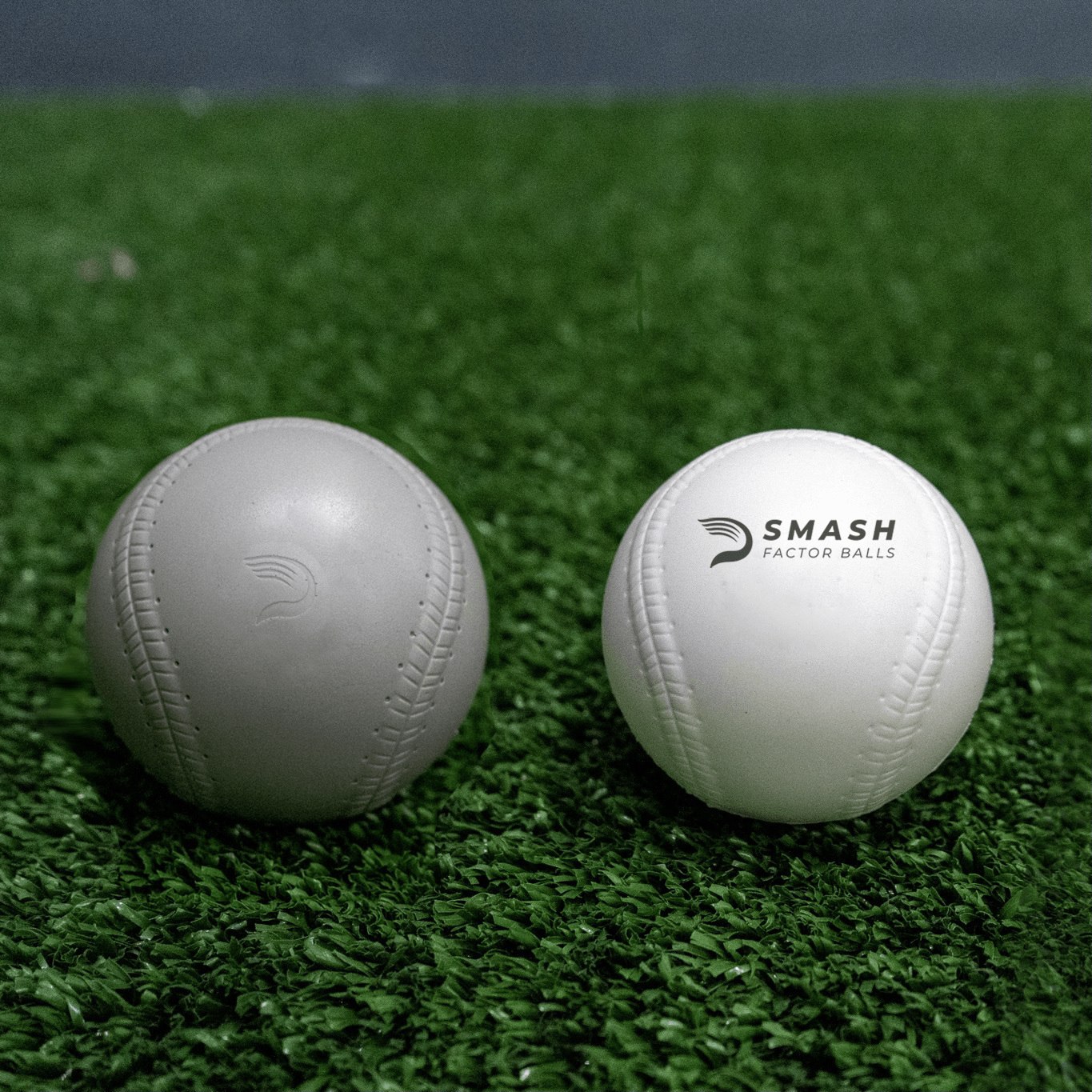Smash Factor Balls™: A New Way to Train Bat to Ball Skills

The best hitters in the world consistently hit the ball on the barrel of the bat. We orient our training around the big three: bat speed, bat-to-ball skills, and swing decisions or approach. In training, Driveline stresses the importance of regularly hitting the ball hard against game-like pitch speeds and shapes.
Our brand-new Smash Factor Balls™ have unlocked new ways of training bat-to-ball skills and bat path for our athletes.
We use these balls with all athletes—MLB, college, high school, all the way down to our 9U Academy teams.
What are Smash Factor Balls™?
They perform like a hitting plyo ball® for the pitching machine.
Smash Factor Balls™ require precise contact and a good bat path to hit them well. Even a slight mishit will result in the ball spinning off the bat.
Made out of spongy foam, Smash Factor Balls™ weigh three ounces and were specifically designed for Driveline Baseball.
They are exactly the same diameter as a regulation baseball, come in two colors, white and gray, in a set of 12 (six of each color).
Why Do We Use Smash Factor Balls™?
Replicating game conditions is critical for effective training.
For that reason, Driveline has always done the majority of the hitting training off high-speed pitching machines and mixed pitch batting practice.
Although pitching machines are a great tool, high-volume, game-speed training has some complications, mostly rooted in the pain of mishitting (jammed or off the end of the bat) a baseball at high speeds.
Fear of pain can throttle the hitter’s swing speed and intent. These lower-intent swings become different from their game swing, which defeats the whole purpose of the training. Smash balls eliminate that fear of pain and allow the hitter to take their game swing every time. The mishits are still obvious, but they aren’t painful and they don’t break your bat.
Eliminating the fear of pain allows hitters to hit more, as their hands aren’t getting sore from the vibrations of mishits.
One advantage hitters have over pitchers is the ability to get more reps. Pitchers can only throw 50-200 high-effort throws each week, but hitters can train a lot more. Driveline hitters often get 1000+ swings a week. Thanks to Smash Factor Balls those swings are near-game efforts plus they don’t have to miss training reps due to sore hands and diminished grip strength.
Smash Factor Balls™ encourage hitters to push the boundaries and challenge themselves more in practice with higher speeds and nastier breaking pitches, which we know is a great way to train.
Hitters are much more willing to face high velo with Smash Factor Balls™ and do drills that push them out of their comfort zones.
“Smash Factor Balls are the best new training tool available to hitters of all levels, hands down. The precise contact required to hit these makes them a tremendous tool for developing bat to ball skills. It’s like a hitting plyo except you use them off the machine at game speeds.
“On top of that, it allows guys to swing with intent off the machine without the fear/pain of getting jammed or hitting it off the end of the bat. Our hitters love them and we hit them every day.”

Jason Ochart
Hitting Coordinator, Philadelphia PhilliesWe use Smash Factor Balls™ in-gym daily because they:
- Improve bat to ball skills or Smash Factor
- Fly like a baseball
- Clean up bat path issues
Improve Bat To Ball Skills or Smash Factor
Pitchers now are optimizing for swing-and-miss stuff on the mound. Every day our pitching trainers are using technology to design high-whiff pitches and talking to our athletes about throwing a higher percentage of their nastiest offspeed pitches.
Across the sport, we are seeing record high swing-and-miss rates in baseball. So many of our hitters in-gym have a focus of improving their bat-to-ball skills.
With Smash Factor Balls™ , we’ve started to even the playing field and really train bat-to-ball skills, as it becomes more valuable in today’s game. And we can train it in high-volumes against pitch shapes guys will actually see in games.
Using Smash Factor Balls™ this last offseason, we saw the best bat-to-ball improvements from our hitters we’ve ever seen.
Fly Like a Baseball
Retain Velocity
So why can’t you grab any old squishy ball and get the same training effects?
Because only Smash Factor Balls™ actually fly like a baseball. They retain baseball-like speeds and break up to 100mph.
We collected pitches with each ball (typical machine ball, baseball, and Smash Factor Ball™) fired from a pitching machine on 3 different velocity settings with spin set at 12 o’clock and 2100 RPM:
- 70 mph
- 85 mph
- 100 mph
The machine was calibrated before each setting adjustment to consistently fire middle-middle.
And Smash Factor Balls™ consistently retain game-like speeds, despite their squishy construction.
When the pitching machine is set at the highest setting (100mph), the other pitching machine balls were topping out around 70 mph while Smash Factor Balls™ were retaining baseball-like speed. We saw some Smash Factor Balls™ out of hand going 105mph.
This plot shows the distribution of plate velocity for all 3 balls in each velocity condition as it crosses the plate:
- Yellow – Other pitching machine balls
- White – Baseballs
- Gray – Smash Factor Balls™
It’s important to note that the velocity reading in mph at the bottom is the velocity of the ball as it crosses home plate, which is typically 8 – 10 mph slower than the pitching machine setting.
How do these balls compare overall?
Plate velocity(mean & std dev):
- Baseball: 70.2 (+- 1.11)
- Smash: 74.7 (+- 1.26)
- Other balls: 61.95 (+-1.02)
When compared to other balls, Smash Factor Balls™ retain (and gain) speed from the machine.
Have Realistic Break Profiles
How do Smash Factor Balls compare to baseballs during flight?
Smash Factor Balls™ behave similar to baseballs, especially at speeds above 80mph.
Below you will find examples of pitch location plots from tests with pitching machines set between 70-100mph.
70 mph
At lower machine velocities, the Smash Factor Balls™ had a similar distribution to baseballs pitch locations.
85 mph
Baseballs and Smash Factor Balls still behaved similarly with Smash Factor Balls having some right-hand glove-side run.
100 mph
For the 100mph test, we used the iPitch. Smash Factor Ball’s™ trajectories remained extremely close to baseballs.
You can dial up MLB-equivalent pitch shapes all without hurting your hands!
Game-like speed with no fear of pain means game-like swings at game-like intent.
Training to Improve Bat Path with Smash Factor Balls™
Driveline hitters will typically start with tee and/or front toss drill work with hitting plyo balls ® and mini hitting plyo balls ® then train those bat-to-ball skills off the high-speed pitching machine using the Smash Factor Balls™.
For our guys that can really square it up, we do warm up drill work with Smash Factor Balls™ off of the short machine.
We want to keep finding environments that challenge our hitters after they’ve done their movement prep but before they lock in to compete in the cage.
The squishy, lightweight construction allows hitters to focus on moving the bat fast without any subconscious fear of getting jammed or hitting the ball off the end of the bat.
How to Train with Smash Factor Balls™
Just as hitting plyo balls® give hitters instantaneous feedback on contact, Smash Factor Balls™ replicate this feedback at game speeds.
Smash Factor Balls™ are versatile: in-season/off-season; indoors/outdoors; pitching machine/BP/front toss/tee.
Smash Factor Balls™ with a skinny bat against the fastball machine is the single best method to train bat-to-ball skills and improve a hitter’s bat path. This requires absolutely perfect contact, and hitter’s love the challenge of it.
We like the Offset Rotation Drill as an example of what you can design using these sets of tools. We use our Axe Smash Bat in this drill to work on bat to ball skills. This drill can be done in a cage, at the park, or in your backyard!
Equipment needed:
1 Smash Bat
5 sets of Smash Factor Balls™
1.) Start in an offset open position
- a.) Line drive in this position x 12
- b.) Maintain swing mechanics
2.) Switch to regular swing
- a.) Line drive in this position x 12
- b.) Maintain swing mechanics
3.) End with offset closed position
- a.) Line drive in this position x 12
- b.) Maintain swing mechanics
The hitter must maintain good bat path and sequencing throughout the 3 positions and the bat/ball combo emphasizes the mistake if they don’t make quality contact.
How to Purchase
We have been experimenting with these for the past year. And our first round of balls was sold out, in private, to 4 MLB, 2 NCAA and 1 NPB teams within a week.
We have limited quantities available for pre-order for fall.
Expected delivery to your door: September 2022
Pre-order them here.
By: Tanner Stokey – Director of Hitting
Comment section
Add a Comment
You must be logged in to post a comment.
scudder.john -
Are these balls safe to use in gymnasiums with strong windows or will they easily break glass? How about racquetball court glass? Also, have you used a hack attack 3 wheel machine to pitch them and how accurate can the machine be with them? Thank you